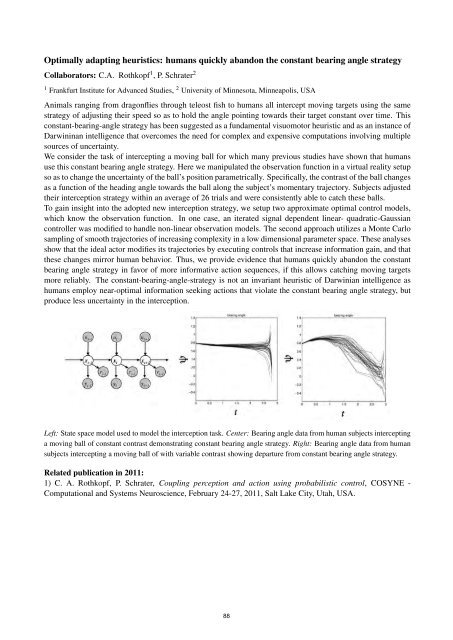FIAS Scientific Report 2011 - Frankfurt Institute for Advanced Studies ...
FIAS Scientific Report 2011 - Frankfurt Institute for Advanced Studies ...
FIAS Scientific Report 2011 - Frankfurt Institute for Advanced Studies ...
You also want an ePaper? Increase the reach of your titles
YUMPU automatically turns print PDFs into web optimized ePapers that Google loves.
Optimally adapting heuristics: humans quickly abandon the constant bearing angle strategy<br />
Collaborators: C.A. Rothkopf 1 , P. Schrater 2<br />
1 <strong>Frankfurt</strong> <strong>Institute</strong> <strong>for</strong> <strong>Advanced</strong> <strong>Studies</strong>, 2 University of Minnesota, Minneapolis, USA<br />
Animals ranging from dragonflies through teleost fish to humans all intercept moving targets using the same<br />
strategy of adjusting their speed so as to hold the angle pointing towards their target constant over time. This<br />
constant-bearing-angle strategy has been suggested as a fundamental visuomotor heuristic and as an instance of<br />
Darwininan intelligence that overcomes the need <strong>for</strong> complex and expensive computations involving multiple<br />
sources of uncertainty.<br />
We consider the task of intercepting a moving ball <strong>for</strong> which many previous studies have shown that humans<br />
use this constant bearing angle strategy. Here we manipulated the observation function in a virtual reality setup<br />
so as to change the uncertainty of the ball’s position parametrically. Specifically, the contrast of the ball changes<br />
as a function of the heading angle towards the ball along the subject’s momentary trajectory. Subjects adjusted<br />
their interception strategy within an average of 26 trials and were consistently able to catch these balls.<br />
To gain insight into the adopted new interception strategy, we setup two approximate optimal control models,<br />
which know the observation function. In one case, an iterated signal dependent linear- quadratic-Gaussian<br />
controller was modified to handle non-linear observation models. The second approach utilizes a Monte Carlo<br />
sampling of smooth trajectories of increasing complexity in a low dimensional parameter space. These analyses<br />
show that the ideal actor modifies its trajectories by executing controls that increase in<strong>for</strong>mation gain, and that<br />
these changes mirror human behavior. Thus, we provide evidence that humans quickly abandon the constant<br />
bearing angle strategy in favor of more in<strong>for</strong>mative action sequences, if this allows catching moving targets<br />
more reliably. The constant-bearing-angle-strategy is not an invariant heuristic of Darwinian intelligence as<br />
humans employ near-optimal in<strong>for</strong>mation seeking actions that violate the constant bearing angle strategy, but<br />
produce less uncertainty in the interception.<br />
Left: State space model used to model the interception task. Center: Bearing angle data from human subjects intercepting<br />
a moving ball of constant contrast demonstrating constant bearing angle strategy. Right: Bearing angle data from human<br />
subjects intercepting a moving ball of with variable contrast showing departure from constant bearing angle strategy.<br />
Related publication in <strong>2011</strong>:<br />
1) C. A. Rothkopf, P. Schrater, Coupling perception and action using probabilistic control, COSYNE -<br />
Computational and Systems Neuroscience, February 24-27, <strong>2011</strong>, Salt Lake City, Utah, USA.<br />
88
















